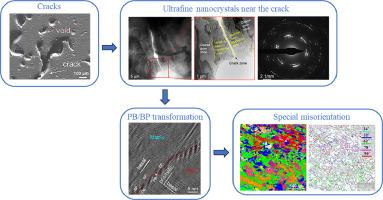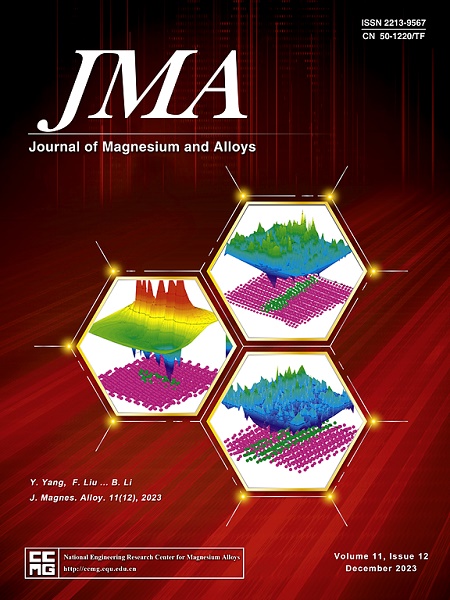Dynamic mechanical response and deformation-induced co-axial nanocrystalline grains facilitating crack formation in magnesium-yttrium alloy
IF 15.8
1区 材料科学
Q1 METALLURGY & METALLURGICAL ENGINEERING
引用次数: 0
Abstract
The dynamic mechanical response and deformation mechanism of magnesium-yttrium alloy at high strain rate were investigated using split-Hopkinson pressure bar (SHPB) impact, and the microstructure evolution and crack formation mechanism were revealed. The yield strength and work hardening rate increase significantly with increasing impact strain rate. Deformation twinning and non-basal dislocation slip are the primary deformation mechanisms during testing. Contrary to crack initiation mechanism facilitated by adiabatic shear bands, we find that high-density co-axial nanocrystalline grains form near cracks, which leads to local softening and promotes crack initiation and rapid propagation. Most grains have similar orientations, with unique misorientation of 24°, 32°, 62°, 78° and 90° between adjacent grains, suggesting that these grains are primarily formed by interface transformation, which exhibits distinct differences from recrystallized grains. Our results shed light upon the dynamic mechanical response and crack formation mechanism in magnesium alloys under impact deformation.


促进镁钇合金裂纹形成的动态机械响应和变形诱导的同轴纳米晶粒
采用劈裂-霍普金森压力棒(SHPB)冲击法研究了镁钇合金在高应变速率下的动态力学响应和变形机理,揭示了微观结构演变和裂纹形成机理。屈服强度和加工硬化率随冲击应变率的增加而显著提高。变形孪晶和非基底位错滑移是测试过程中的主要变形机制。与绝热剪切带促进的裂纹萌发机制相反,我们发现高密度同轴纳米晶粒在裂纹附近形成,从而导致局部软化并促进裂纹萌发和快速扩展。大多数晶粒具有相似的〈1¯21¯0〉〈1¯21¯0〉取向,相邻晶粒之间存在 24°、32°、62°、78° 和 90°的独特错向,表明这些晶粒主要由界面转化形成,与再结晶晶粒存在明显差异。我们的研究结果揭示了镁合金在冲击变形下的动态机械响应和裂纹形成机制。
本文章由计算机程序翻译,如有差异,请以英文原文为准。
求助全文
约1分钟内获得全文
求助全文
来源期刊

Journal of Magnesium and Alloys
Engineering-Mechanics of Materials
CiteScore
20.20
自引率
14.80%
发文量
52
审稿时长
59 days
期刊介绍:
The Journal of Magnesium and Alloys serves as a global platform for both theoretical and experimental studies in magnesium science and engineering. It welcomes submissions investigating various scientific and engineering factors impacting the metallurgy, processing, microstructure, properties, and applications of magnesium and alloys. The journal covers all aspects of magnesium and alloy research, including raw materials, alloy casting, extrusion and deformation, corrosion and surface treatment, joining and machining, simulation and modeling, microstructure evolution and mechanical properties, new alloy development, magnesium-based composites, bio-materials and energy materials, applications, and recycling.
 求助内容:
求助内容: 应助结果提醒方式:
应助结果提醒方式:


